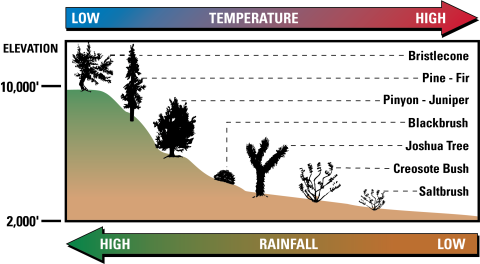Saltbrush Community
Below 2,400 feet (700 m)
In some basins on the valley floors, particularly those with low nocturnal temperatures and very high soil salinity, the saltbrush community predominates. A good example of this community can be found on the valley floor between Corn Creek Field Station and Highway 95.
Creosote Bush Community
2,400-3,600 feet (700-1,100 m)
This open scrubland dominated by the creosote bush consists of widely spaced shrubs and various cacti. Other common species include Mojave yucca, bursage, and range ratney. This community receives less than 5" of rain per year.
Joshua Tree Woodland
3,000-5,000 feet (900-1,500 m)
The apparently dominant species in this habitat type is the Joshua tree, although the bulk of plant material consists of a variety of widely spaced shrubs known as the understory.
Blackbrush Community
4,200-6,000 feet (1,300-1,800 m)
This community dominated by blackbrush is found on steep rolling hills. Soils are typically shallow. Different species of yucca, including Joshua tree, Mormon tea, and cholla cactus are common here.
Pinyon-Juniper Woodland
6,000-7,500 feet (1,800-2,300 m)
This open canopy forest occurs where precipitation may be 10–15" per year, much of which is received as snow. Utah juniper and single-leaf pinyon pine dominate this community that forms a zone between brush and true forest.
Pine-Fir Forest
7,500-9,000 feet (2,300-2,750 m)
Where snow and rain linger, ponderosa pine and white fir are dominant. They form well developed, nearly closed canopy forests.
Bristlecone Pine
Near 10,000 feet (3,000 m)
Where the growing seasons are the shortest, the only trees surviving the extreme conditions are the bristlecone pines. These very long lived trees are found in the Sheep Mountain Range.
Life Zones in the Mojave Desert




